Homer Davenport
Oregon's Great Cartoonist
By Walt Curtis © 2002
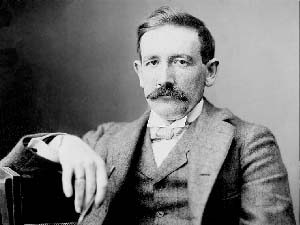 Homer Davenport (1867-1912), the Silverton
cartoonist, is one of Oregon's most extraordinary celebrities. Through
the support of formidable newspaperman William Randolph Hearst, he
would become the most influential political cartoonist in the U.S.A.
Homer Davenport (1867-1912), the Silverton
cartoonist, is one of Oregon's most extraordinary celebrities. Through
the support of formidable newspaperman William Randolph Hearst, he
would become the most influential political cartoonist in the U.S.A.
Millions saw his cartoons. Hearst used his darling "Davvy" as a point man muckraking against political bosses and big trusts such as Standard Oil Company. Davenport cartoons, with direction from Hearst, ushered in the Progressive Era and promoted the ascendancy of the American Empire. Breaking with Hearst, Davenport helped reelect Teddy Roosevelt to the presidency in 1904. One might argue that he had more impact on the American way of life than radical journalist John Reed or poet-lawyer C.E.S. Wood, both Oregonians and players on the national scene.
Yet Homer Davenport's life is an enigma. Did this fantastic success bring him happiness? It is doubtful he ever would have left his beloved Silverton if his father Timothy W. hadn't cajoled, encouraged, and pushed his reluctant son toward a career in the arts. Homer remained homesick for his small town on the edge of the Willamette Valley all of his life.
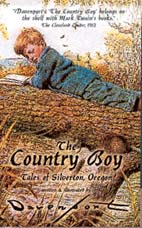 The Country Boy, published in 1910, is an Oregon classic of small-town
American life. The book is the coming-of-age memoir of a mid-1880s
Oregonian, which parallels the coming of age of millions of Americans
on the brink of the Twentieth Century. The Cleveland Leader said,
"Davenport's The Country Boy belongs on the shelf with Mark Twain's
books." Privately printed, it might have become a bestseller if it had
been properly distributed. After all, Homer Davenport was a household
name. Like Norman Rockwell paintings and Garrison Keillor's "Lake
Woebegon," The Country Boy was already nostalgia when it appeared.
Except in Davenport's world, these aren't middleclass pretensions. As a
work of literature, this true-life memoir is droll, surprising,
sentimental, and vaudevillian. Often, the author is the butt of his own
description.
The Country Boy, published in 1910, is an Oregon classic of small-town
American life. The book is the coming-of-age memoir of a mid-1880s
Oregonian, which parallels the coming of age of millions of Americans
on the brink of the Twentieth Century. The Cleveland Leader said,
"Davenport's The Country Boy belongs on the shelf with Mark Twain's
books." Privately printed, it might have become a bestseller if it had
been properly distributed. After all, Homer Davenport was a household
name. Like Norman Rockwell paintings and Garrison Keillor's "Lake
Woebegon," The Country Boy was already nostalgia when it appeared.
Except in Davenport's world, these aren't middleclass pretensions. As a
work of literature, this true-life memoir is droll, surprising,
sentimental, and vaudevillian. Often, the author is the butt of his own
description.
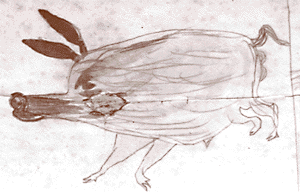 Homer's
life from the very beginning is improbable. When his mother Florinda
Geer was pregnant, she obsessed on Thomas Nast cartoons in Harper's
Weekly. She was convinced that one day her son would become as famous
as Nast. To this end, she followed the recommended proper diet and deep
concentration in the medical essay "How To Born A Genius" by Dr.
Russell Trall. Young Homer, born March 8, 1867, was sketching pigs and
horses on the Geer homestead in the Waldo Hills by age three and a
half. This property is today a "century farm," and the renowned "Riding
Whip Tree," which the boy played under, still stands. It grew from a
cottonwood switch pushed into the ground by his mother
Homer's
life from the very beginning is improbable. When his mother Florinda
Geer was pregnant, she obsessed on Thomas Nast cartoons in Harper's
Weekly. She was convinced that one day her son would become as famous
as Nast. To this end, she followed the recommended proper diet and deep
concentration in the medical essay "How To Born A Genius" by Dr.
Russell Trall. Young Homer, born March 8, 1867, was sketching pigs and
horses on the Geer homestead in the Waldo Hills by age three and a
half. This property is today a "century farm," and the renowned "Riding
Whip Tree," which the boy played under, still stands. It grew from a
cottonwood switch pushed into the ground by his mother
Tragedy suddenly struck the pioneer Davenport family in 1870. An outbreak of smallpox attacked the community. Florinda was fatally stricken. The pox left Homer's face scarred, but the death of his beautiful mother was life-altering. Florinda was 33 years old. The antique-looking photograph of mother and son is the frontispiece to The Country Boy. Florinda's dying words to her husband went: "You must take another wife, butmy prophecymy dreammy little son will be a cartoonist. Give him every opportunity."
Dad's perseverance and patience is the stuff of sainthood. The story of the cartoonist is also the father's. They bonded, perhaps because of the mother's death. Why did the Davenports move to Silverton, a town of 300 inhabitants? Homer was 7 years old. The father had given up a beautiful 1851 farm he loved, carved from the Oregon wilds, so his son could have a future "in the Latin Quarter of that village."
Timothy was a well-educated professional who held numerous high-profile jobs - Indian agent, Oregon State Representative, and land agent. He played the violin and loved the classics. His son must've pained him sorely those first 25 years, the period of time covered by The Country Boy. All he required from Homer, besides milking the cows, was to "study faces and draw." The townsfolk cannot understand why this strapping, healthy young man is lounging around, doing nothing.
As with everything Homer Calvin Davenport did, the apocryphal and the anecdotal can't do justice to real events. Truth outstrips storytelling. For 70 years, rare book dealers searched for the title The Belle of Silverton, and Other Oregon Stories (1888-1889), tale of a girl he incapably courted. The book didn't exist. As a joke, the author included it in the short bibliography of his works. I am indebted to Homer Davenport of Silverton (1973), the accurate biography compiled by Oregon's great bookman Alfred Powers and researcher Leland Huot. It is a detailed account of his life and career in a limited edition of 700.
Powers and Huot sort out the many false starts, numerous part-time jobs young Homer held before going to San Francisco. He was a jockey in Salem and became a clown in McMahon's one-ring circus. Maybe he learned to draw the Republican elephant and the Tammany tiger there. He slept on pool tables and posted handbills on walls for Clara Morris in Camille. Sister Adda and he cried all the way through the tearjerker. Dad sent him to Armstrong Business School in Portland, and he failed.
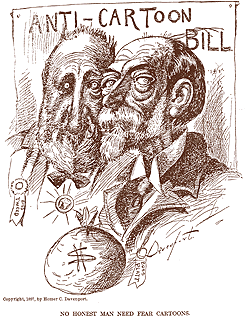 Before cartooning, railroading was his most consistent job. He was a
wiper on the shiny No.8 engine, as his bull terrier Duff rode upfront
on the cowcatcher. Trains gave the country boy freedom and access to
the world. At the freight office in West Stayton Homer sketched a
portrait of his best friend "Duffy" on the wall. Years later,
firefighters saved the drawing, shouting, "Let the damned building go,
but save the cartoon!"
Before cartooning, railroading was his most consistent job. He was a
wiper on the shiny No.8 engine, as his bull terrier Duff rode upfront
on the cowcatcher. Trains gave the country boy freedom and access to
the world. At the freight office in West Stayton Homer sketched a
portrait of his best friend "Duffy" on the wall. Years later,
firefighters saved the drawing, shouting, "Let the damned building go,
but save the cartoon!"
About 1890 Homer started his career in Portland. He sketched the steamboat "Harvest Queen," running the Cascade rapids on the Columbia for The Oregonian. No pay. He struggled with spelling, and many of his cartoon captions needed correction.
The big break came in January of 1891. The Portland Sunday Mercury, a sporting weekly, put him on a train for New Orleans to cover the Dempsey-Fitzsimmons fight. Jack (Nonpareil) Dempsey was a popular middleweight champion from Portland. Homer brought back an alligator that froze in Denver and gamecocks that made it to Silverton - "Dempsey" and "Fitzsimmons." His 21 views of the fight were said to have been extremely accurate. They are now "lost," but on the trip his skills - verbal, social, and artistic - emerged. Destiny intervened.
In 1892, his father sends him to San Francisco, prepared to attend art school. The rural youth is in shock, alone in an alien world. A relative, C.W. Smith, a general manager at the Associated Press, got the Davenport boy a letter of introduction to the San Francisco Examiner - the Hearst paper. Davenport actually went to work, earning two dollars and fifty cents a week at The Examiner. Formally trained staff artists ridiculed his homespun style. He later worked briefly at The Chronicle. He's 25 years old.
Finding it hard to settle down, he yearns to go to the Chicago World's Fair - the Columbian Exposition. Again Smith of Associated Press helped him land a job with the Chicago Daily Herald. Romantic interest Daisy Moor visited, and they're soon married. The Panic of 1893 took him back to San Francisco and The Chronicle art department. A rivalry between the two papers was going on, and Homer's popular work caught Hearst's attention, who soon offered him $75 a week, a princely sum at the time.
Davenport's small town ethics, largely absorbed from his father, inspired his cartoons. The skill that Davenport possessed was a photographic eye and a naturalistic style. He could look at someone, draw a realistic cartoon, and divulge the person's character. Hearst published his portrait of Sam Rainey, the powerful political boss never previously portrayed, filling the entire front page of The Examiner. Influential politicos in California both feared and admired the caricatures. They wanted to hang them on the wall, as well as beat him up!
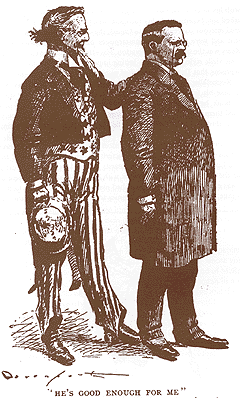 The relationship between Hearst and Davenport evolved into something
remarkable. They were like brothers! Hearst was his boss, but also his
strongest advocate. The Powers-Huot biography reports: "A paper in the
East wants me to join it," he told Hearst.
The relationship between Hearst and Davenport evolved into something
remarkable. They were like brothers! Hearst was his boss, but also his
strongest advocate. The Powers-Huot biography reports: "A paper in the
East wants me to join it," he told Hearst.
"What does the paper offer?"
"A hundred a week."
"My God, Davvy, that's as much as the managing editor gets."
"I sure hate to leave you, Mr. Hearst."
"Davvy, you're not leaving," Hearst replied.
In October of 1895, the hotshot publisher called his brilliant editor Arthur Brisbane and cartoonist Davenport to New York City. This team of young men would change the business! Shake up the world. The Evening Journal increased its circulation to a million in 6 years. In this time of mogul capitalism and American jingoism, Hearst's paper flamboyantly exposed the trusts and the graft of political bosses. Of course, this was done to sell newspapers. Populism in full swing, the American people were hungry for social and political justice.
Davenport was in demand and made tons of money. His work was syndicated on both coasts. At the height of his career, he was making $25,000 a year, the same salary as the President. Davenport's Uncle Sams were the most expressive and reassuring ever done. The American people could relate to this tall, Lincolnesque leader lecturing Boss Hanna's "The Brute," holding the hand of the waif Cuba during the Spanish-American War. Homer restored Admiral Dewey's popularity after his marriage to a rich widow. His cartoons reflected the troubled, empire-building era. Hearst was a genius at yellow journalism and his mother's silver dynasty millions paid the bills in his press war with Joseph Pulitzer.
A bit of an egomaniac, Citizen Hearst tried for the Democratic nomination to the presidency, and failed. After personally meeting candidate Theodore Roosevelt - noting his energy and charisma - Davenport abruptly left Hearst's paper, The New York Journal, in mid-1903. He would not go back until 1911, a year before his death. The Republicans paid him $1,000 a week for six months. They spent $200,000 circulating the largest vote-getting cartoon in the history of American politics. Davenport drew Uncle Sam with his hand on the shoulder of T.R., and the caption "He's Good Enough For Me."
After Homer left Hearst, Major Pond - Twain's booking agent - sent him out on the lecture circuit. He ensconced the family first at East Orange, New Jersey, and later on the "Davenport Estate," a stud farm at Morris Plains.
In his biography HOMER, The Country Boy (1986), horse lover Mickey Hickman, a Silverton resident, documents every aspect of Davenport's fascinating book My Quest of the Arab Horse (1909). Both books are treasure troves of Arabian horse lore. President Roosevelt's personal letter to the Sultan of Turkey asked for an "Irwade," a special permit authorizing his friend Homer to import the Arabians. It made sense that the White House "Rough Rider" would be interested in such an adventure.
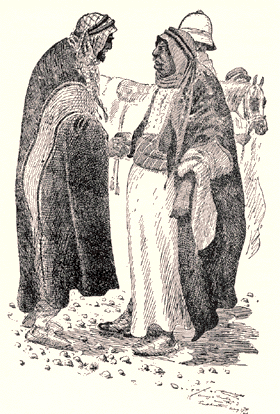 Hickman rediscovered the glass slides and lantern projector Davenport
used in his lectures when he returned from the desert. The photographs
of Homer on a camel, his friend Akmet Haffez, the encampment of wild
Anazeh Bedouin preparing for war - this is the stuff of Lawrence of
Arabia. As a present of brotherhood, he is given Wadduda, the favorite
war mare of Sheik Hashem Bey, along with her keeper Said Abdallah. By
Allah, the coincidences continue! Till then, no brood mare was allowed
outside of the Ottoman Empire. The 27 pureblooded Arabians he imported
enhance the bloodlines of America's most famous horses.
Hickman rediscovered the glass slides and lantern projector Davenport
used in his lectures when he returned from the desert. The photographs
of Homer on a camel, his friend Akmet Haffez, the encampment of wild
Anazeh Bedouin preparing for war - this is the stuff of Lawrence of
Arabia. As a present of brotherhood, he is given Wadduda, the favorite
war mare of Sheik Hashem Bey, along with her keeper Said Abdallah. By
Allah, the coincidences continue! Till then, no brood mare was allowed
outside of the Ottoman Empire. The 27 pureblooded Arabians he imported
enhance the bloodlines of America's most famous horses.
The 1906 journey by Davenport to the Anazeh Bedouins was the highpoint of his life. He secretly drew the Sultan, a feeble old man, and hid the drawing in a bale of hay. The temperature was 135 degrees in the shade of the tent. Overcome by emotion, Homer realizes: "Ever since a small boy, I knew that I was just as much of an Arab as any in the desert. I had been one of its members all of my life." Among these restless people, Davenport experienced something transcendental, beyond time.
Back in Morris Plains, the Bedouin stable boy Said Abdallah slept with the horses. There were pens and aviaries of exotic birds. Davenport commuted to work everyday on the Millionaire Specialthe lifestyle of the Rich and Famous. The 27 acres of hill, wood, and stream possessed a huge stable and stalls for his prized Arabians. The modest farmhouse had a back porch with 2 clapboard walls, autographed by boxers, actors, and artists at his annual barbecue. Buffalo Bill and his troupe came out on the commuter train, as did Lillian Russell, boxers Fitzsimmons and John L. Sullivan, and the lavishly gowned Flora-Dora girls.
Great men trusted him instinctively. Even enemies like Boss "Dollar Sign" Hanna forgave his insults. Davenport's eyes were tired and all-knowing. He comfortably wore an old slouch hat. No longer a country boy, but a sophisticated man. Davenport genuinely liked people and, chameleon-like, had the ability to get along with everyone, except his spouse. The beautiful and fashionable Daisy did not like Silverton, especially when he took her there to honeymoon.
Davenport was also a spiritualist. His father believed in an afterlife. There are strong elements of predestination in his life, work, and tragic death. The fatal flaw was the marriage. Homer Jr. sided with Daisy. Davenport wanted a peaceful separation from her, because she was a good mother. He wrote his father in July of 1907: "I am sickened and tired of the meaningless conversations. I have taken a great change, growth toward a higher plain, in which there is happiness." By March 1909, he was out of the house at Morris Plains, on the edge of a nervous breakdown. Famous ex-professional baseball pitcher A.G. Spalding offered an oasis in San Diego.
He deeded everything to his wife. Still she was suing for alimony. Under doctor's care, he thought of lecturing again. Catherine Tingley, the leading authority on theosophy, at the Raga Yoga Colony was a spiritual mentor. He relieved himself of his sorrows in the San Diego Sun of Feb. 3, 1910, in a rambling 3-page article - "Davenport Explains Troubles With Wife." Somehow he pulled himself together to publish The Country Boy. He had fallen in love with a mysterious woman named Zadah. When Hearst heard that Davenport wanted to work again, he wired him a one-liner: "Dear Davvy: Come home. Hearst."
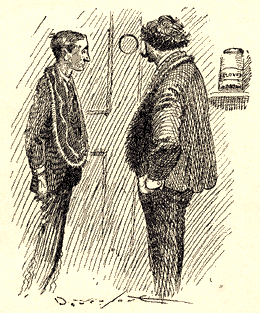 Everything
was looking up, in spite of his father's death in 1911. Davenport felt
positive about the upcoming divorce trial. He would be free to marry.
Instead, Hearst sent him to cover the survivors from the sinking of the
Titanic. He drew a great hand rising out of the water and pulling the
ship under.
Everything
was looking up, in spite of his father's death in 1911. Davenport felt
positive about the upcoming divorce trial. He would be free to marry.
Instead, Hearst sent him to cover the survivors from the sinking of the
Titanic. He drew a great hand rising out of the water and pulling the
ship under.
He suffered a nervous collapse, and was convalescing at the home of Mrs. Cochran well known in mediumistic circles as ASSONATH NEYPA. At the end, the eight doctors in attendance couldn't save him from pneumonia. He died on May 2, 1912 at 45. Was fatalism at work? Every element in his life was coming together. Yet suddenly Davenport is dead, one year after his father's demise almost to the day.
Hearst paid for the funeral expenses. Davenport's great gray rectangular tombstone, paid for by popular subscription, was inscribed: "Erected by his friends to the Memory of Oregon's world-renowned Cartoonist." Pictured on the back was "The Journey Across" - showing a man in a chariot driven by an angel. Looking back on his earthly home, Silverton. Homer sketched the image when his father died and commented: "The saddest trip West I ever made...as I drew it in en route. It also depicts an important change in his life for the better." He was buried next to his beloved father.
Fate works its maneuvers in strange ways. A mother's prophecy came true! Homer was blessed as an artist with the incomparable gift of seeing and drawing. A country boy's dream of owning and riding desert stallions was life-defining. Ninety years after his passing, Silverton still honors the prodigal son every August with oompah bands performing in the park and amateur art shows - Homer Davenport Days. The humble yet thoroughly humorous account you are about to enjoy was written by a 43-year-old author at the height of a fabulous career to recapture the memories evoked by his beloved hometown throughout an amazing life.
Walt Curtis is Portland's unofficial poet laureate. He is the author of numerous small-press books, including The Erotic Flying Machine, The Roses of Portland, Rhymes For Alice Blue Light, and Mala Noche. The last book was the source for Gus Van Sant's first feature film, and in 1995 he starred in Bill Plympton's documentary Walt Curtis: The Peckerneck Poet. For 30 years, he has co-hosted a poetry program, "The Talking Earth," on KBOO-FM radio in Portland. Curtis is the current secretary and one of the founders of the Oregon Cultural Heritage Commission.
Books by Homer Davenport:
- Cartoons, 1898
- The Dollar or the Man, 1900
- My Quest of the Arabian Horse, B.W. Dodge & Company, New York, 1909
- The Country Boy, G.W. Dillingham Company, New York, 1910
- Homer Davenport of Silverton, Leland Huot and Alfred Powers, West Shore Press, Bingen, Washington, 1973
- Homer: The Country Boy, Mickey Hickman, Capital City Graphics, Salem, Oregon, 1986










